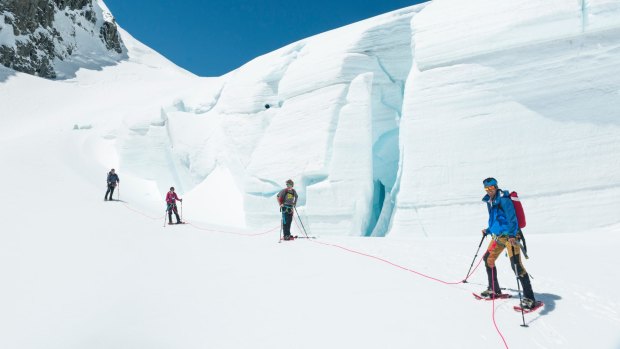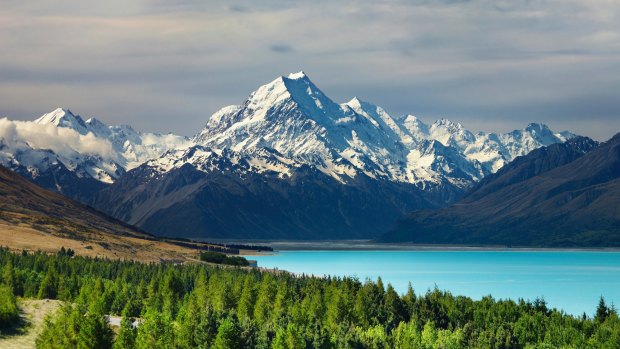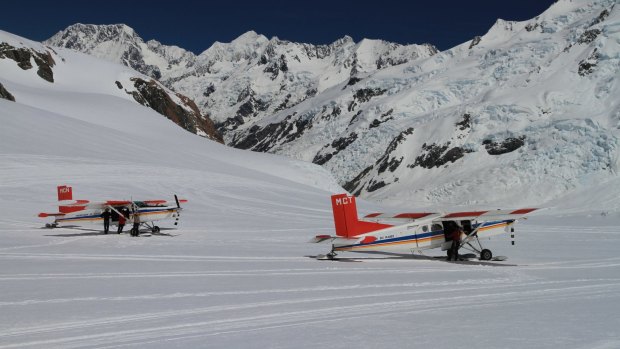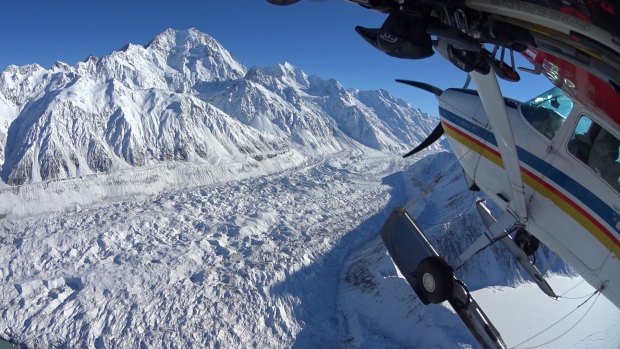This was published 6 years ago
New Zealand adventure tours: Glacier guiding at Aoraki Mount Cook
By Steve Meacham

Mt Cook Glacier Guiding.Credit: Petr Hlavacek
Climbing into this Mount Cook ski plane is like stepping back into the history of New Zealand's adventure sports.
Over 60 years ago (in September 1955) Sir Henry Wigley – a former World War II pilot, pre-war captain of the NZ downhill ski team, and tourism pioneer – successfully landed a plane similar to this Pilatus Porter on the Tasman glacier, the longest in the country at 23 kilometres.
"Harry" Wigley's flight that day was the first time in history a plane have been able to take off on wheels, land on snow, take off on snow and touch down again – safely – back on land.

Mount Cook and Pukaki lake, New Zealand.Credit: iStock
Today we're used to helicopters doing the same thing.
But back then, Wigley was on the cutting edge of mountain technology. He designed the ingeniously retractable wooden skis on his original ski plane himself.
And, being an entrepreneur, Wigley made sure his first commercial flight received the most publicity possible by inviting Sir Edmund Hilary – recent "conqueror" of Mount Everest who had done so much of his training on Mount Cook.

In 1955, tourism pioneer Sir Henry Wigley successfully landed a plane on the Tasman glacier. Over 60 years later, Mount Cook Glacier Guiding has started offering the skiplane option again.
Six decades later, Mount Cook is known as Aoraki Mount Cook (putting its Maori name first). The UNESCO World Heritage-listed national park bearing its name – with its peaks, glaciers, snowfields and ice caves – is familiar to anyone who has ever watched Sir Peter Jackson's movie versions of Tolkien's The Hobbit or Lord of the Rings.
Tourists have been able to enjoy guided glacier tours since 1928 on the Fox and Franz Joseph glaciers on the western side of the Southern Alps. And there are now three commercial operators offering helicopter tours of the Tasman glacier from Mount Cook airport.
But it has only been since November 2016 that Mount Cook Glacier Guiding began once again offering the ski plane/snowshoe option pioneered by Wigley all those years ago.

The 15-minute flight to the upper neve is breathtaking, but landing on the snow in a plane at 2200 metres is the highlight.
"We named this trip 'The Wigley' after Harry," our guide, "Tex", had told us when we were getting kitted out with boots, warm jacket, gloves, ski poles, backpack – and, of course, modern snow shoes. "Ski planes are very rare these days and we're the only company that operates a ski plane as well as helicopters."
Tex – real name Geoffrey Delaune, but born in Texas – has been glacier guiding for 11 years mainly on the Fox glacier (Texas isn't known for its glaciers!).
"Glacier guiding at Mount Cook is a relatively new thing," Tex told our group of five who have signed up for the snowshoe adventure (the maximum is six guests per trip).
So what's the difference between a tour on the Fox and one on the Tasman? "The biggest difference is the spectacular mountain scenery on this side," Tex explained. "When we get up there, you'll not only see Mount Cook but be surrounded by 50 glaciers.
"The Tasman is much flatter than the Fox, so the hard ice features like ice caves are less dramatic. But when you're on the Fox, you're looking at temperate rainforest and the west coast. Here the ambience is totally alpine."
Fortunately we've been blessed with an awesome day, with cloudless blue skies surrounding the magnificent peaks which loom high above the village of Mount Cook. Clearly, all glacier tours are weather dependent. "It rains less this side of Mount Cook, but we still get four metres of rain every year," Tex pointed out.
Our ski plane takes off from the Mount Cook runway and heads up the Tasman valley. Like most glaciers the Tasman is divided into three sections. At the very top is the "upper neve" – the permanent snowfield – that feeds the glacier. At the centre is the hard ice section, where you'll see the blue ice features and ice caves which most visitors come to see. At the bottom is the dirty brown section containing the rocks and soil that are being carved and carried out of the mountain as the glacier moves down, eventually forming a barrier of moraine.
We fly over the Tasman saddle hut at the higher reaches of the glacier, and head higher still – far beyond the summer snow line. The 15-minute flight to the upper neve is breathtaking, but landing on the snow in a plane at 2200 metres is the highlight.
Once we're out of the plane and on the snow, we are quickly roped up. "It's actually more dangerous above the snow line, because you can't see the hazards, whereas when you're on hard ice you can see everything," Tex said.
Now it's time to test our skills with the snowshoes. Mankind has been using them for at least 4000 years, possibly 6000 years. They are believed to have been invented in central Asia and carried to the Americas by the ancestors of present day Inuit.
These modern versions are much easier to use (as Tex said: "If you can walk, you can snowshoe"). Although the glacier is bending and contorting as it drops in altitude, the terrain is gradual. Most of the two hours on the glacier is spent walking on rolling hills of snow, with plenty of stops and photo opportunities with the "seracs" – big pinnacles or walls of ice which poke up through the snow.
Back on board the Pilatus Porter, there's one last highlight. The flight back to the airport gives us a close-up view of the stunning ice formations of the Hochstetter Icefall beneath the east face of Aoraki Mount Cook.
"Next time you're here you should try our ice climbing trip," Tex tells us. "We're on the ice for up to six hours, and we'll teach how [to] master basic crampon and ice axe techniques. You'll climb walls of ice and perhaps even be lowered down into a crevasse."
TRIP NOTES
MORE INFORMATION
GETTING THERE
Mount Cook village is 334km from Christchurch and 258km from Queenstown by road.
STAYING THERE
Mount Cook village has many accommodation options, from backpacker to luxury. See www.mackenzienz.com.
Alternatively, Lakestone Lodge, on Lake Pukaki, is 60km from Mount Cook village. See www.lakestonelodge.co.nz.
TRAVELLING THERE
Mt Cook Glacier Guiding offers various trips, including The Wigley for $NZ549 per person, from Aoraki Mt Cook Airport. Freephone 0800 68 2665 or www.mtcookguides.co.nz.
Steve Meacham was a guest of Christchurch & Canterbury Tourism.
Sign up for the Traveller Deals newsletter
Get exclusive travel deals delivered straight to your inbox. Sign up now.